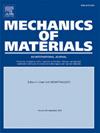Unusual temperature dependent core properties of <110> superdislocation in Ni3Al by ab initio results-informed fully discrete Peierls-Nabarro model
IF 3.4
3区 材料科学
Q2 MATERIALS SCIENCE, MULTIDISCIPLINARY
引用次数: 0
Abstract
Using ab initio results-informed fully discrete Peierls-Nabarro (FDPN) model, temperature-dependent <110> superdislocation core properties are investigated for Ni3Al in the present work. A specific numerical method has been developed to solve the Landau equation of the FDPN model. Our results show that the density functional theory (DFT) can effectively calculate the γ-surface and elastic constants of Ni3Al over a wide temperature range of 0∼1200 K. It is found that the core energy of type the I′ superdislocation is always lower than that of the type I within the considered temperature range, making the type I′ configuration more energetically favorable. Furthermore, the splitting distances of both types exhibit an unexpected temperature dependency, with abrupt changes occurring at specific temperatures. With increasing temperature, the Peierls stresses for both types of superdislocations do not change monotonically, but vary in a sinusoidal-like or one-peak form. Such phenomenon may be attributed to the transition of superdislocation core structure between the O-mode and B-mode as the temperature changes. These findings allow for a deeper understanding of superdislocation evolution and corresponding temperature-dependent plastic behavior of Ni3Al.
求助全文
约1分钟内获得全文
求助全文
来源期刊

Mechanics of Materials
工程技术-材料科学:综合
CiteScore
7.60
自引率
5.10%
发文量
243
审稿时长
46 days
期刊介绍:
Mechanics of Materials is a forum for original scientific research on the flow, fracture, and general constitutive behavior of geophysical, geotechnical and technological materials, with balanced coverage of advanced technological and natural materials, with balanced coverage of theoretical, experimental, and field investigations. Of special concern are macroscopic predictions based on microscopic models, identification of microscopic structures from limited overall macroscopic data, experimental and field results that lead to fundamental understanding of the behavior of materials, and coordinated experimental and analytical investigations that culminate in theories with predictive quality.
 求助内容:
求助内容: 应助结果提醒方式:
应助结果提醒方式:


